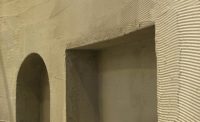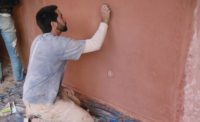Enigmatic, exotic, artisanal, rustic, seductive—just a few of the superlatives that attempt to capture the essence of Tadelakt, the plaster of Marrakech that has in recent years fascinated the imagination of the Western design world. This occurred first in France. Quite naturally as Morocco is a former French protectorate, continues to be French speaking, and remains a popular destination for holiday or retirement. French designers fell in love with the Moroccan aesthetic incorporating it into the haute couture of Parisian interior architectural design. It did not take long for Tadelakt to catch on throughout the luxury markets of Europe, the United Kingdom and United States.
A number of years ago, I accompanied a team from Venice organized by a true master of the Italian tradition, Franco Saladino, to study Tadelakt application and manufacture. We were all immediately seduced with the food, the music, the “terroir,” the culture, and of course the plasterwork of Morocco. One of my plaster colleagues in the U.S., Ryan Chivers, made a similar visit and was likewise enthralled. Ryan and I will do our best to share what we’ve learned of its tradition, manufacture, and in a subsequent article the application of Moroccan Tadelakt.
History and Tradition
The word Tadelakt is an English transliteration from Arabic, meaning “massaged” or alternatively “rubbed” or “kneaded.” The name is meaningful and a big hint to what Tadelakt is all about. For now, we’ll answer the question, “What is it?” by considering the material aspect of Tadelakt with its peculiar properties.
Lime burning for plaster manufacture has been going on for a long time in North Africa. We know Egypt for example was using gypsum and lime plasters for the construction of the pyramids and other structures dating back 5,000 years ago. However, it was under the Almoravid “Berber” dynasty of the 11th century based in Marrakech that artisans began to use the locally produced lime to waterproof the royal cisterns.
The limestone used to produce Tadelakt comes from the High Atlas Mountains to the east. The limestone is argillaceous, meaning it contains a relatively high percentage clay. Also, there is a small infiltration of amorphous silica making Tadelakt lime slightly hydraulic. Combining its natural properties with traditional application methods Tadelakt’s waterproofing qualities were subsequently put to decorative use in exterior façades, small drinking vessels and famously the “hammams” or public bath houses.
Manufacture
The Tadelakt factories are found at the foothills of the High Atlas Mountains. The factories are little more than a flat stretch of land with a series of cylindrical pits lined with adobe bricks. Each pit has a tight tunnel entrance leading to the floor of the pit so fuel can be added during the baking. The limestone is broken down to more or less grapefruit-sized pieces. There is no mechanical equipment so all the work is done by hand breaking one stone against another. Then a vault is carefully arranged by hand over the pit. It is very important that the sizes of each stone are approximately the same so that there is an even baking. Too large and the carbon will not be completely driven off. Too small and there is a vitrification of the silicates. Either way you can end up with a lot of useless chunks.
This is precisely the same process outlined by Vitruvius and utilized by the Romans two millennia ago to produce lime plaster. The Arabs had preserved many of the old Roman texts and during their golden age translated many Greek and Latin documents into Arabic. Tadelakt is essentially a natural hydraulic lime utilizing limestone local to Marrakech.
The very effective fuel for the furnace comes from the surrounding fields, a plentiful brush high in natural oils that are set aside and dried weeks in advance. The temperature is raised to about 1,750 degrees Fahrenheit (950 degrees Celsius), which is maintained for at least 24 hours under the careful supervision of an experienced baker. There of course is no thermometer. He determines the temperature by observing the color of the flame and the smell of the smoke.
After another full day of cooling the vault is broken down and carted away. If the limestone was properly baked, the stones will fall to powder by lightly spraying with water. The reaction is quick producing a good amount of heat, though not as much as a pure quicklime. Finally, the slaked plaster is put through a series of sieves to remove over or under cooked chunks. This is typically done in the open air by two men holding and shaking a large manual screen approximately 3 feet by 8 feet with an assistant throwing the plaster on it. The Tadelakt lime will stay highly active if quickly packaged and stored to prevent carbonation with the air.
Next Time
In our next article, we’ll consider Tadelakt not as a material, rather the traditional application in Morocco that is a handcrafted art involving quite a bit of elbow grease. We’ll also consider contemporary application techniques that have allowed Tadelakt to be specified and applied successively with the type of substrates we typically encounter in modern construction.














